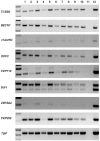Identification and characterization of peripheral T-cell lymphoma-associated SEREX antigens
- PMID: 21887344
- PMCID: PMC3161784
- DOI: 10.1371/journal.pone.0023916
Identification and characterization of peripheral T-cell lymphoma-associated SEREX antigens
Abstract
Peripheral T-cell lymphomas (PTCL) are generally less common and pursue a more aggressive clinical course than B-cell lymphomas, with the T-cell phenotype itself being a poor prognostic factor in adult non-Hodgkin lymphoma (NHL). With notable exceptions such as ALK(+) anaplastic large cell lymphoma (ALCL, ALK+), the molecular abnormalities in PTCL remain poorly characterised. We had previously identified circulating antibodies to ALK in patients with ALCL, ALK(+). Thus, as a strategy to identify potential antigens associated with the pathogenesis of PTCL, not otherwise specified (PTCL, NOS), we screened a testis cDNA library with sera from four PTCL, NOS patients using the SEREX (serological analysis of recombinant cDNA expression libraries) technique. We identified nine PTCL, NOS-associated antigens whose immunological reactivity was further investigated using sera from 52 B- and T-cell lymphoma patients and 17 normal controls. The centrosomal protein CEP250 was specifically recognised by patients sera and showed increased protein expression in cell lines derived from T-cell versus B-cell malignancies. TCEB3, BECN1, and two previously uncharacterised proteins, c14orf93 and ZBTB44, were preferentially recognised by patients' sera. Transcripts for all nine genes were identified in 39 cancer cell lines and the five genes encoding preferentially lymphoma-recognised antigens were widely expressed in normal tissues and mononuclear cell subsets. In summary, this study identifies novel molecules that are immunologically recognised in vivo by patients with PTCL, NOS. Future studies are needed to determine whether these tumor antigens play a role in the pathogenesis of PTCL.
Conflict of interest statement
Figures





Similar articles
-
Diagnostic and prognostic implications of tumor expression of the GATA-3 gene in nodal peripheral T-cell lymphoma (nPTCL): Retrospective data from a Latin American cohort.Leuk Res. 2022 Mar;114:106794. doi: 10.1016/j.leukres.2022.106794. Epub 2022 Feb 1. Leuk Res. 2022. PMID: 35131666
-
Clinical and prognostic differences between ALK-negative anaplastic large cell lymphoma and peripheral T cell lymphoma, not otherwise specified: a single institution experience.Ann Hematol. 2016 Aug;95(8):1271-80. doi: 10.1007/s00277-016-2696-9. Epub 2016 May 21. Ann Hematol. 2016. PMID: 27209536
-
ALK- anaplastic large-cell lymphoma is clinically and immunophenotypically different from both ALK+ ALCL and peripheral T-cell lymphoma, not otherwise specified: report from the International Peripheral T-Cell Lymphoma Project.Blood. 2008 Jun 15;111(12):5496-504. doi: 10.1182/blood-2008-01-134270. Epub 2008 Apr 2. Blood. 2008. PMID: 18385450
-
Anaplastic large cell lymphoma, ALK-negative.Crit Rev Oncol Hematol. 2013 Feb;85(2):206-15. doi: 10.1016/j.critrevonc.2012.06.004. Epub 2012 Jul 11. Crit Rev Oncol Hematol. 2013. PMID: 22789917 Review.
-
Peripheral T-cell lymphoma--not otherwise specified.Crit Rev Oncol Hematol. 2011 Sep;79(3):321-9. doi: 10.1016/j.critrevonc.2010.07.007. Epub 2010 Aug 10. Crit Rev Oncol Hematol. 2011. PMID: 20702104 Review.
Cited by
-
Construction of random tumor transcriptome expression library for creating and selecting novel tumor antigens.Tumour Biol. 2016 Sep;37(9):12877-12887. doi: 10.1007/s13277-016-5201-0. Epub 2016 Jul 23. Tumour Biol. 2016. PMID: 27449040
-
A rational roadmap for SARS-CoV-2/COVID-19 pharmacotherapeutic research and development: IUPHAR Review 29.Br J Pharmacol. 2020 Nov;177(21):4942-4966. doi: 10.1111/bph.15094. Epub 2020 Jul 19. Br J Pharmacol. 2020. PMID: 32358833 Free PMC article. Review.
-
Rtfc (4931414P19Rik) Regulates in vitro Thyroid Differentiation and in vivo Thyroid Function.Sci Rep. 2017 Feb 23;7:43396. doi: 10.1038/srep43396. Sci Rep. 2017. PMID: 28230092 Free PMC article.
-
CEP proteins: the knights of centrosome dynasty.Protoplasma. 2013 Oct;250(5):965-83. doi: 10.1007/s00709-013-0488-9. Epub 2013 Feb 28. Protoplasma. 2013. PMID: 23456457 Review.
-
Proteomic profile and in silico analysis in metastatic melanoma with and without BRAF mutation.PLoS One. 2014 Dec 1;9(12):e112025. doi: 10.1371/journal.pone.0112025. eCollection 2014. PLoS One. 2014. PMID: 25437182 Free PMC article.
References
-
- The Non-Hodgkin's Lymphoma Classification Project. A clinical evaluation of the International Lymphoma Study Group classification of non-Hodgkin's lymphoma. Blood. 1997;89:3909–3918. - PubMed
-
- Swerdlow SH, Campo E, Harris NL, Jaffe ES, Pileri SA, et al., editors. WHO Classification of Tumours of Haematopoietic and Lymphoid Tissues. Lyon: IARC; 2008.
-
- Jaffe E, Harris N, Stein H, Vardiman J. Pathology and genetics: tumours of haematopoietic and lymphoid tissues. In: Kleihues P, Sobin L, editors. World Health Organization Classification of Tumours. Lyon: IARC Press; 2001. pp. 190–235.
-
- Went P, Agostinelli C, Gallamini A, Piccaluga PP, Ascani S, et al. Marker expression in peripheral T-cell lymphoma: a proposed clinical-pathologic prognostic score. J Clin Oncol. 2006;24:2472–2479. - PubMed
-
- Lepretre S, Buchonnet G, Stamatoullas A, Lenain P, Duval C, et al. Chromosome abnormalities in peripheral T-cell lymphoma. Cancer Genet Cytogenet. 2000;117:71–79. - PubMed
Publication types
MeSH terms
Substances
LinkOut - more resources
Full Text Sources

